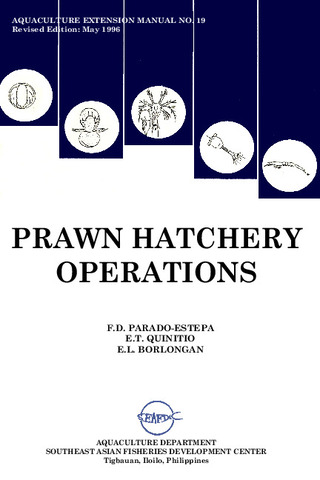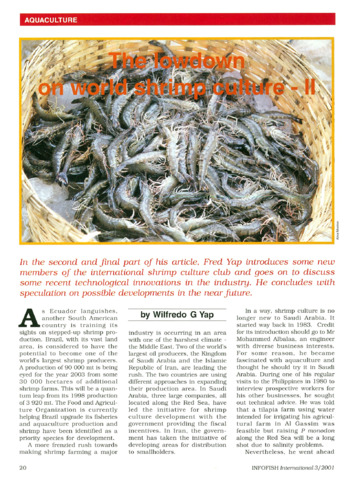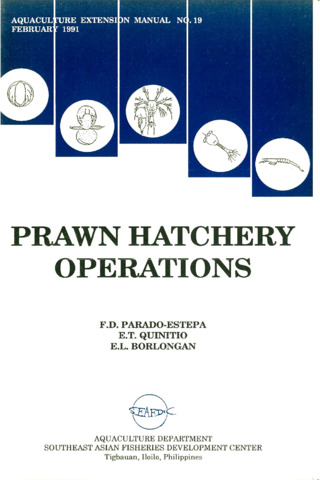Histopathology of a novel melanized lesion in the branchiostegite of cultured penaeid shrimps
- Global styles
- MLA
- Vancouver
- Elsevier - Harvard
- APA
- Help

View/
Date
2002Page views
464ASFA keyword
AGROVOC keyword
Taxonomic term
Metadata
Show full item record
Share
Abstract
During routine investigations for white spot syndrome virus (WSSV) in shrimp farms of Kundapur in the West Coast of India, a novel melanized proliferative lesion was observed in the branchiostegite of Penaeus monodon and P. indicus. This lesion appeared as faint or dark fingerprint, a black patch visible from outside, or an outgrowth visible from inside. A lesion progressed from faint fingerprint like melanized pattern to a proliferative outgrowth. Intermediate stages appeared as melanized dark fingerprints and black patch formation. Gross examination, wet mounts and histological observations revealed that the outer cuticle was normal and melanization took place in the inner thin membranous cuticle of the branchiostegite. The outgrowth, when present, was made up of three distinct layers composed of epidermal, fibrous, and an outer acellular layer. The etiology of the lesion is uncertain but it appears that its formation is in response to foreign agents in the culture system. This paper provides gross and histopathological descriptions of this novel lesion.
Suggested Citation
Ahmed, I., Mohan, C. V., Shankar, K. M., & Ramesh, K. S. (2002). Histopathology of a novel melanized lesion in the branchiostegite of cultured penaeid shrimps. In C. R. Lavilla-Pitogo & E. R. Cruz-Lacierda (Eds.), Diseases in Asian aquaculture IV: Proceedings of the Fourth Symposium on Diseases in Asian Aquaculture, 22-26 November 1999, Cebu City, Philippines (pp. 159-165). Fish Health Section, Asian Fisheries Society.
Type
Conference paperISBN
9718020160Collections
Related items
Showing items related by title, author, creator and subject.
-
Series: Aquaculture extension manual; No. 19
Prawn hatchery operations
Parado-Estepa, Fe D.; Quinitio, Emilia T. ; Borlongan, Emeterio L. (Aquaculture Department, Southeast Asian Fisheries Development Center, 1996-05)
The manual, an updated version of the 1984 SEAFDEC/AQD manual, presents the underlying principles and step-by-step instructions of prawn larval and post-larval rearing. The techniques described are not only applicable to ...
; Borlongan, Emeterio L. (Aquaculture Department, Southeast Asian Fisheries Development Center, 1996-05)
The manual, an updated version of the 1984 SEAFDEC/AQD manual, presents the underlying principles and step-by-step instructions of prawn larval and post-larval rearing. The techniques described are not only applicable to ... -
The lowdown on world shrimp culture - II
Yap, Wilfredo G. (INFOFISH, 2001)This paper introduces some new members of the international shrimp culture club and goes on to discuss some recent technological innovations in the industry, particularly the polyculture of tilapia (mainly Oreochromis ... -
Series: Aquaculture extension manual; No. 19
Prawn hatchery operations
Parado-Estepa, Fe D.; Quinitio, Emilia T. ; Borlongan, Emeterio L. (Aquaculture Department, Southeast Asian Fisheries Development Center, 1991-02)
The manual, an updated version of the 1984 SEAFDEC/AQD manual, presents the underlying principles and step-by-step instructions of prawn larval and post-larval rearing. The techniques described are not only applicable to ...
; Borlongan, Emeterio L. (Aquaculture Department, Southeast Asian Fisheries Development Center, 1991-02)
The manual, an updated version of the 1984 SEAFDEC/AQD manual, presents the underlying principles and step-by-step instructions of prawn larval and post-larval rearing. The techniques described are not only applicable to ...





